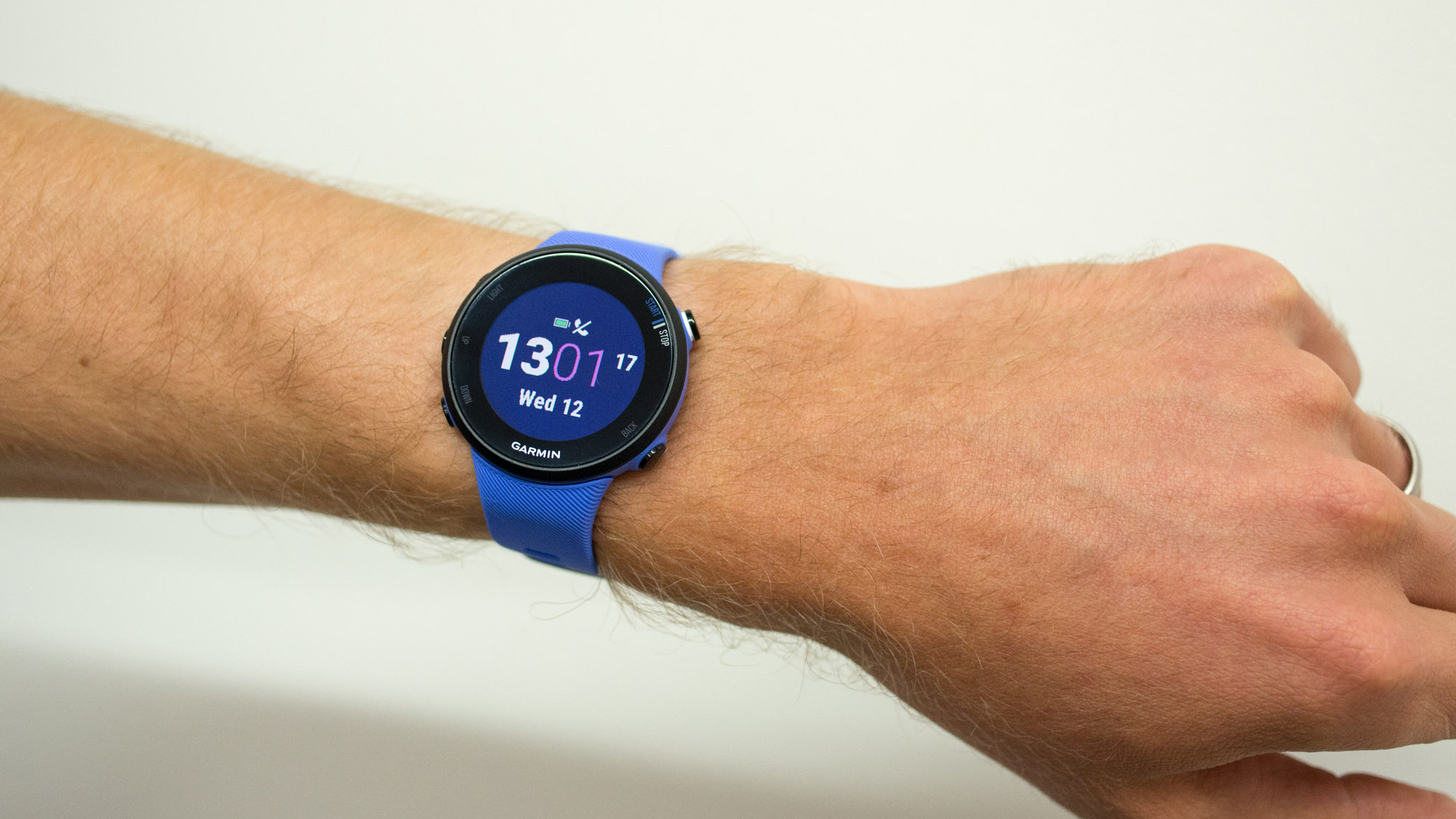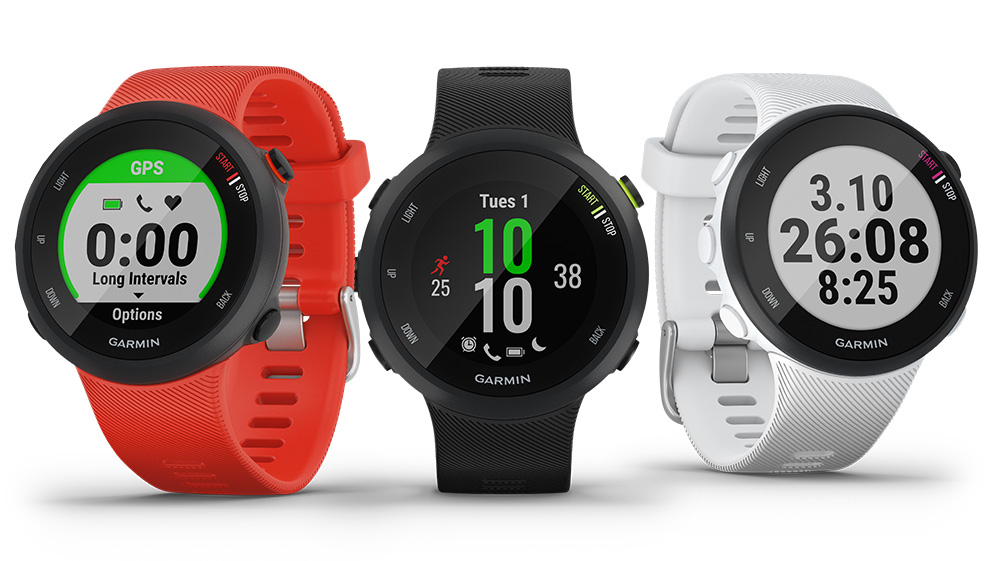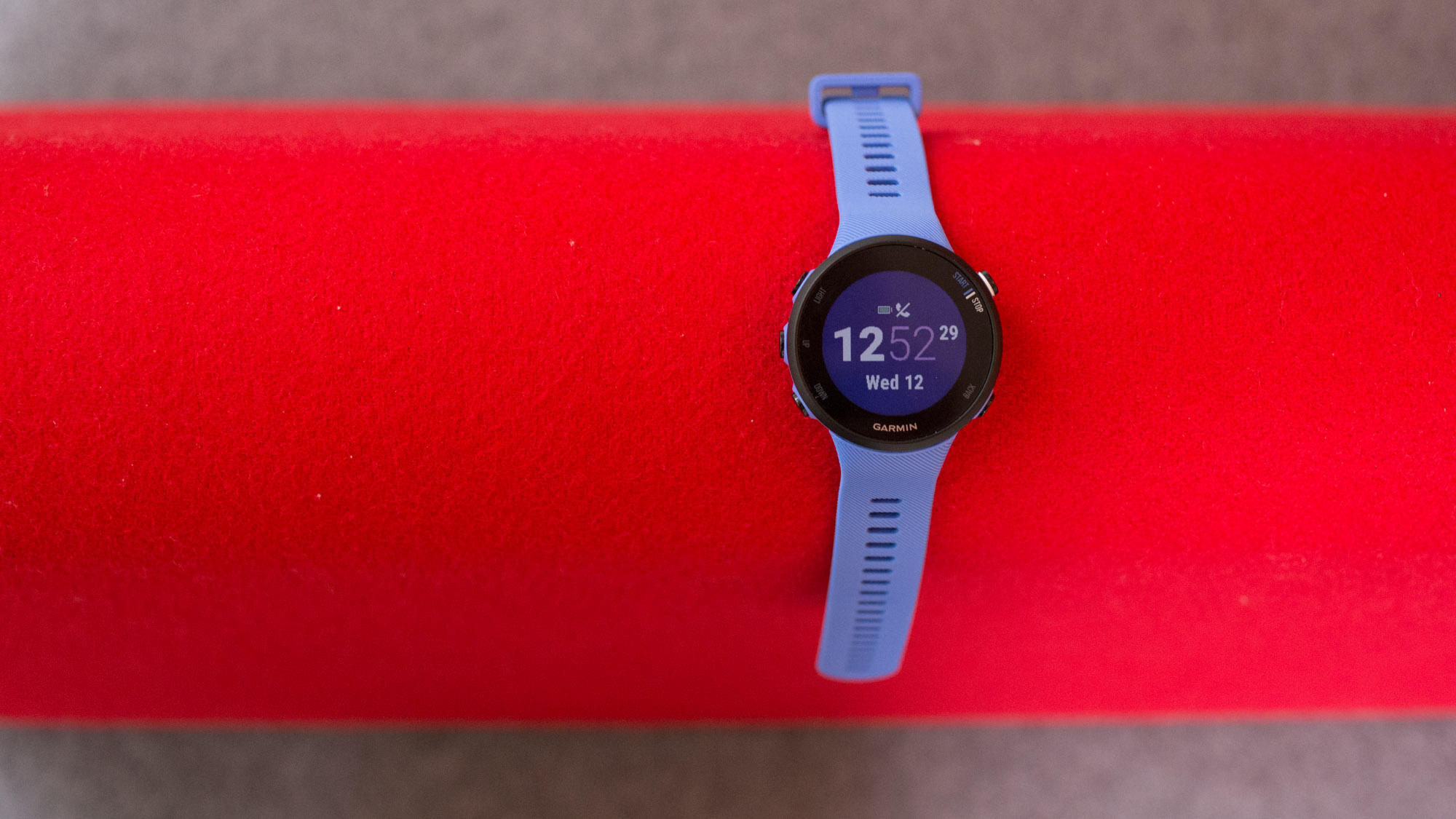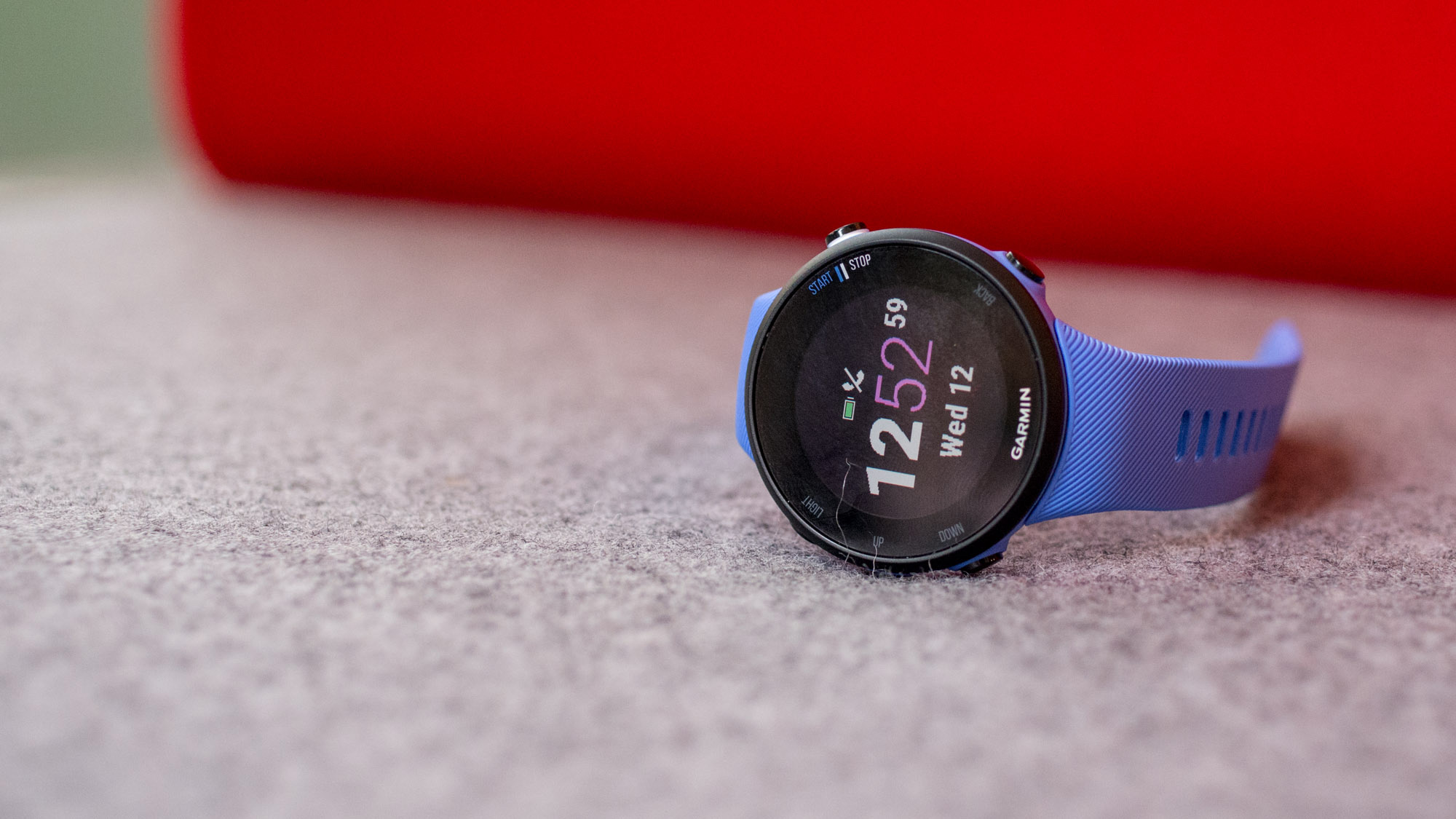Our Verdict
The Garmin Forerunner 45 replaces the Forerunner 35 as the best budget running watch, offering genuinely useful features to enhance your training like structured workouts and training plans for standard race distances on top of the reliably excellent and easy-to-use Garmin sports tracking. However, there are other sports watches and smartwatches that are similarly priced and which will probably be more appealing to non-runners – the new Polar Ignite in particular stands out as the best all-round option under £200.
For
- A winning combination of accurate sports tracking in an easy-to-use package.
- Training plans for events like a 5K or half marathon can be synced to the 45, with the watch guiding you through each session. You can also create your own structured workouts for the watch to guide you through.
- There’s a greater range of sports modes than on the Forerunner 35, with useful additions like yoga and a general cardio mode.
- The 45 will also track your everyday activity and goes beyond basic step tracking, telling you how much energy you have left with Body Battery, as well as monitoring your stress levels.
Against
- There’s no swimming mode on the watch, even though it’s waterproof.
- The 45 doesn’t have any smart features beyond basic notifications.
- The design isn’t as appealing as that of the competition.
- Basic and often inaccurate sleep tracking.
You can trust Coach
Should I Consider Buying Something Else? (Updated August 2021)
- NEWS FLASH: New Garmin Forerunner watches improve GPS accuracy, here’s what else is new on the 255 and 955
- First-look Garmin Forerunner 255 review
- First-look Garmin Forerunner 955 review
When the Forerunner 45 launched in 2019 this was a fairly easy question to answer. If you were a dedicated runner and had a budget of £200 then it was the clear choice among the best running watches.
However, both Garmin and other companies have since released running watches that usurped the Forerunner 45. The Garmin Forerunner 55, the successor to the 45, substantially improves the battery life to 20 hours of GPS as well as adding useful running features like suggested runs each day, recovery advice and a track run mode.
There is also the Coros Pace 2 to consider, which costs the same as the Forerunner 55 at £180 but offers a more extensive feature set, including detailed training analysis, a multisport mode and 30 hours of GPS battery life in an equally small and lightweight watch. The Pace 2 offers better value for more experienced runners and triathletes, though the Forerunner 55 has a lot to recommend it to beginners thanks to its guided training features.

The Forerunner 45 is still worth considering, though, because it remains a solid budget watch and with the release of the new generation it’s ripe for price reductions. If it drops close to £100, it might well offer better value to runners who don’t feel the need for more battery or the new features on the 55.
Finally, if you’re more of a gym-goer than a runner, the Polar Ignite 2 (£199.50) is a better bet than the Forerunner 45. The watch is not quite as useful for runners as the Forerunner 45, but it’s still a competent running watch and it also offers impressive sleep analysis features that inform daily workout recommendations based on how well recovered and ready to train you are that day.
Garmin Forerunner 45 In-Depth
Running With The Garmin Forerunner 45
You can have up to six different sports modes on the Forerunner 45 but it’s a run tracker first and foremost, and a damn fine run tracker at that.
First, the basics. You can set up the watch to show up to three stats on each data screen and the Forerunner 45 has GPS (the American satellite system), GLONASS (the Russian one) and Galileo (the European one) to call on when tracking your outdoor runs. I’ve found the best set-up to be GPS + Galileo, which has achieved accurate tracking even when running under tree cover in Epping Forest.
The 45 also has Garmin’s Elevate optical heart rate monitor and this proved exceptionally accurate during my runs. The small, light build of the device means you can tighten it against your wrist comfortably, which helps to deliver accurate heart rate data even when running intervals. You can link an external heart rate monitor to the 45 via ANT+ (not Bluetooth) but in my experience the optical was tracking good enough that you wouldn’t need to worry about this even if you’re basing workouts on your heart rate.
However, what really separates the 45 from its predecessor – and other budget running watches – is the integration of Garmin Coach and having the ability to follow structured workouts on the watch. Garmin Coach is a new feature in the Garmin Connect app that lets you set up training plans for 5K, 10K and half marathon events, which are automatically tailored to your running level. These plans are aimed at beginner and improver runners, and include workouts designed to improve your fitness and speed, and hone your running technique through drills, which are demonstrated in videos in the app.
Once your plan is synced over to the 45 it will flag up what workout you have on any given day and guide you through it, displaying your targets for each interval, whether you’re working to time, pace or even cadence.
Garmin Coach is very easy to set up and use, and there’s no doubt that if you follow the variety of workouts in each plan you will arrive at your event in better shape than if you’d just gone out for the same steady run in each of your training sessions. If you’re a new runner tackling your first event, or an improver chasing a certain time, Garmin Coach’s integration with the 45 is one of the watch’s most attractive features.
The feature is less useful for more experienced runners at the moment, though I’d expect more advanced training plans to arrive on Garmin Coach in time, but runners who are following more complicated plans can create their own workouts in the Garmin Connect app and sync them to the 45 to follow. This is easy to do and something that several other brands don’t offer – Suunto and Coros running watches, for example, only allow you to create simple interval workouts to follow. On the 45 you can set up workouts containing intervals of varying lengths with targets based on things like heart rate, pace, time and distance, which makes them a lot easier to follow than if you have to remember them and track them manually using the lap button.
The addition of structured workouts plus Garmin Coach on top of the accurate distance and heart rate tracking make the 45 a watch that will appeal to all levels of runner. It’s at its most useful for beginners, I’d say, and it lacks the in-depth training analysis you’ll find on more expensive Forerunners that might appeal to intermediate and advanced runners. It’s also short of the smart features like music storage, which you can get on devices in its price bracket like the Fitbit Versa and Samsung Galaxy Active. If running is your priority, however, it has all the essentials and performs brilliantly.
Sports Tracking With The Garmin Forerunner 45
The Forerunner 45 offers 12 sports modes in the Garmin Connect app, from which you can select up to six to have on the watch itself. Alongside running and cycling (indoors and out), there are dedicated modes for things like yoga and a general cardio workouts. What it doesn’t have is a swimming mode, which is a shame because it is waterproof to 50m.
For the most part all you’re really getting from these modes is time, calories burned and your heart rate, though for outdoor cycling you also get speed and distance. You can also link up cycling speed/cadence sensors, but not a power meter.
Overall the Forerunner 45 offers enough when it comes to other sports that it would satisfy a runner who cross-trains, though not one who does so by swimming. It’s a little sparse in truth, especially compared with the 100-plus sports modes on the new Polar Ignite watch, which will also guide you through short workouts each day, or the workout modes you can get on smartwatches in the sub-£200 price bracket. However, the Forerunner 45 is a running watch first, second and third, so it’s not surprising that it lacks a little focus when it comes to other sports.

Activity Tracking With The Garmin Forerunner 45
There are advantages to wearing the Forerunner 45 at all times and the device goes beyond the basics in everyday activity tracking, offering insight into your stress levels and overall energy levels on top of the usual array of stats including steps, calories burned, active minutes and 24/7 heart rate monitoring. The steps goal can also be set to adjust automatically in line with your activity, which helps ensure you always have a challenging but attainable target to keep you engaged.
Stress levels are tracked by measuring your heart rate variability, while your overall energy is given a score out of 100 by the Body Battery feature. Your score drops after activities and rises when you sleep. It’s a nice, clear stat that can help you gauge whether you should be doing that planned long run or easing off with a short, gentle jog instead.
The Forerunner 45 definitely offers enough insights into your everyday activity for you to make it your sole timepiece. Whether you’ll want to depends on how you feel about having a sports watch strapped to your wrist at work or when heading out in the evening.
Sleep Tracking With The Garmin Forerunner 45
The Forerunner 45 does record sleep but the tracking is fairly basic, providing info on your overall time asleep and any periods you were awake during the night, along with a graph of your movement. It’s not in-depth and it’s not always particularly accurate either. I found the 45 tended to overestimate my sleep time by classifying periods when I was lying still reading or watching TV as sleep.
Garmin offers more advanced sleep monitoring on its more expensive watches, but even then it doesn’t have the depth of detail you get from the likes of Fitbit and Polar.
How Often Am I Going To Have To Charge It?
Garmin lists the Forerunner 45’s battery life as seven days in watch mode and 13 hours of GPS. I found that with a busy training schedule where I’d run or cycle at least once every day it would last around four days.

Where Can I Wear It Without People Laughing At Me?
Unless you opt for one of the more colourful designs the 45 will fit in just about anywhere, but it is clearly a sports watch, and less attractive than some of Garmin’s more premium options like the Forerunner 945 or Fenix 5 Plus Series. It’s not as appealing to wear 24/7 as a fitness smartwatch like the Fitbit Versa or Samsung Galaxy Active either, owing to the dimmer screen, and the Polar Ignite also beats in the looks department. The Forerunner 45 isn’t ugly, but to my tastes Garmin’s design hasn’t kept pace with that of its rivals in the bargain bracket.

Nick Harris-Fry is a journalist who has been covering health and fitness since 2015. Nick is an avid runner, covering 70-110km a week, which gives him ample opportunity to test a wide range of running shoes and running gear. He is also the chief tester for fitness trackers and running watches, treadmills and exercise bikes, and workout headphones.

